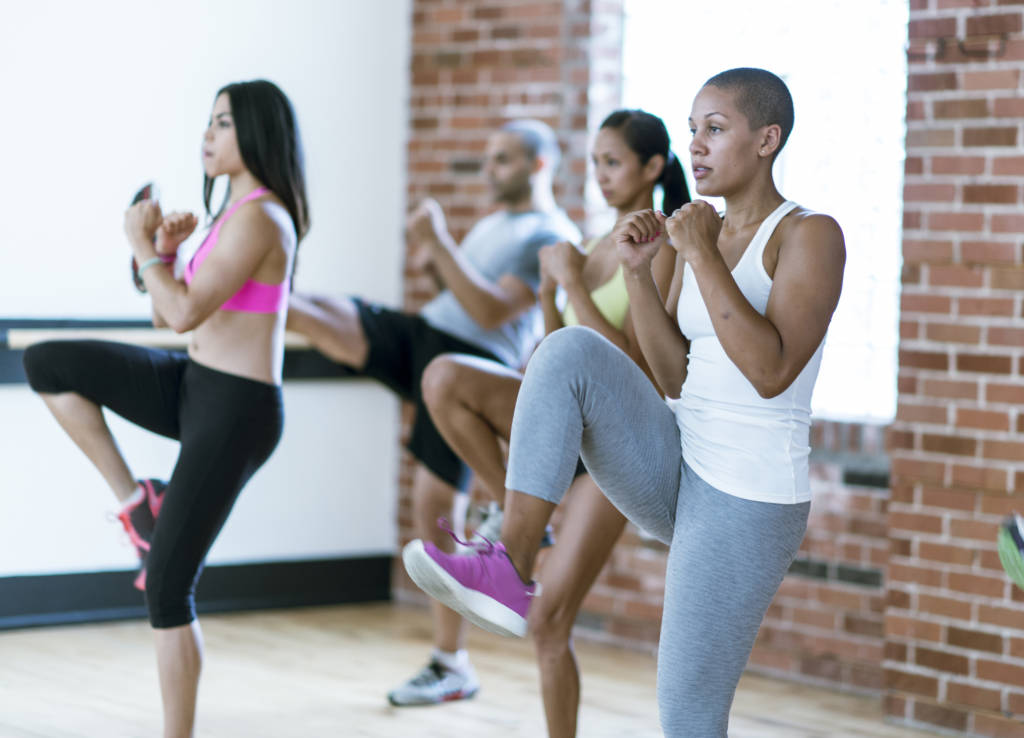
All the rage at fitness centers around the country, this workout borrows moves from the Thai sport of kickboxing to make participants work up a sweat. A typical hour-long class will take place in the center’s aerobics studio. With everyone facing the mirror, a teacher leads the group through specific punches and kicks, usually to the beat of dance-club music.
The moves are worked into swiftly executed combinations (for example: jab, cross punch, hook, uppercut, front kick). Some teachers mix in a few minutes of jumping rope (often as a warm-up) and conditioning drills reminiscent of high-school gym class (jumping jacks, sideways scooting steps).
What are the benefits?
Although it may seem as if every new exercise trend is hailed as “a full-body workout,” these classes can come pretty close. If you do the punches with precision and power, you’ll strengthen your upper body and eventually see more muscle definition.
The kicks will strengthen your legs, especially the hamstrings (the muscles that run down the backs of your thighs). And the kneeing move (a strike in which you thrust your bent knee upward) will firm your abdominal muscles; in fact, all of the moves, when done correctly, will make your torso into a solid base that lets you do everyday tasks more easily – whether you’re hoisting a heavy box into your attic crawl space or shoving open a window that always sticks.
Your cardiovascular system will benefit, too, though how much depends on the class. Some teachers offer a truly aerobic workout — they keep you bobbing, weaving, and jumping amidst the punches and kicks, so that your heart rate stays elevated for most of the session.
Other teachers may not have you move around as much, focusing more on proper form. Either way, a good class will leave you drenched in sweat and energized.
What’s more, a lot of people find kickboxing a great way to release stress. Civilized as we’ve all been not to hit each other (which is, of course, a good thing), we’re still animals with some natural aggression. You may find that planting your heel in the torso of a phantom foe 10 or 20 times leaves you feeling wonderfully tranquil.
This workout doesn’t suit all temperaments and bodies, however. If you’re happy with your current exercise plan, don’t feel you need to switch. The best form of exercise is the one you feel comfortable doing. If you’re a bit accident prone or troubled by a stiff back or tight hamstrings, kickboxing might bring you more troubles than benefits.
How can I find a good class?
Take the time to observe some classes at reputable health clubs, YMCAs, or exercise studios in your area. You want a teacher who will inspire you to work hard but won’t intimidate you. In addition to her general attitude, note whether she goes through a warm-up at the beginning of the session, explains the moves clearly, and ends with a cooldown and stretching.
A good teacher also corrects individuals when their form is off, rouses the group’s energy with reminders to stay focused and “keep it up,” and doesn’t push newcomers as hard as class regulars. She tries to make the experience fun, too; after all, you’re not really in training for the ring.
Learning from a video isn’t a great idea. But if you live in an area that hasn’t embraced the kickboxing trend yet and you’re determined to try, do some research: Read reviews of the various video workouts in fitness magazines and at the online booksellers’ sites, and talk to anyone you know who has used the videos.
The American Council on Exercise also has a page called Kick Your Way to Fitness that you should read before you sock it to your imaginary opponent.
What should I expect in my first class?
Be prepared to feel a little clumsy and lost at times – and don’t get down on yourself for it. Even if you’re a highly conditioned runner or you’ve been doing step aerobics for years, these moves are new to your body. Your muscles need time to develop a “memory” of them, and your reactions as the teacher calls out what to do (“jab, cross, hook, roundhouse”) will be slow at first. By the second or third class, the awkwardness will start to dissipate.
The first thing you’ll learn is the stance — a way of standing that maximizes balance and puts power behind your moves. Your feet are about shoulder-width apart and at a slight angle, one foot set back from the other. Your fists are up around your temples to guard your face. (Don’t hunch your shoulders.) This is the position you’ll return to after every punch and kick.
Different instructors have different takes on the subtleties of positioning, but the basics that you learn from one teacher will hold up when you try someone else’s class. The punches generally taught are the jab, cross, hook, and uppercut; kicks will likely include the front kick, side kick, and roundhouse.
What should I wear?
Sweats, shorts and a T-shirt, an aerobic-dance outfit — whatever keeps you comfortable and cool. Wear well-made athletic shoes that aren’t too worn. Running shoes aren’t ideal because they’re not constructed for side-to-side movements. A better choice might be high-top cross trainers.
Could I hurt myself?
Yes. If you’re not careful, you could end up with a wrenched elbow, a sprained knee, a strained back, a pulled hamstring, or one of the injuries that commonly occur in aerobics classes, such as a twisted ankle.
So adopt a protective attitude toward that capable body of yours (think of how much it’s done for you): When you take your first few classes, tell yourself that your goal is to safely learn the techniques and not to shed five pounds or reshape your hips (you can think about those things later).
If you can spare the time, arrive a few minutes early and warm up by pedaling a stationary bike or jogging for a few minutes. Then gently stretch your legs (especially the fronts and backs of the thighs) and shoulders; lengthen your back by extending your arms overhead and stretching upward from your hips or by doing the “downward dog” yoga pose, if you know it.
During the class, make sure that you stop the motion of each punch or kick before the joint is fully extended. Don’t snap those elbows; an injury there can take a long time to heal. Also, kick low and with control. Forget about the person next to you; if she wants to kick the ceiling fans, that’s her business. Respect your body’s limits. Sure, you can change those limits — but it’ll take time, dedication, and a realistic attitude.
Will cardio kickboxing give me skills to defend myself?
Not as it’s taught at your local health club. In most classes, you’ll be shadow boxing (not making contact with a punching bag or resistance pad) as well as pulling your punches. This style of “fighting” can’t prepare you for a physical struggle with an attacker.
Even if your class lets you whale on a punching bag and your teacher drills you in parrying blows, you won’t practice shouting for help or learn how to lower your chances of being assaulted. If you want to learn self-defense tactics, take a self-defense class.
How can I get the most out of kickboxing?
As with any other exercise, if you want to improve your cardiovascular condition or trim an inch here and there, you’ll have to do it regularly. Two or three sessions a week is probably the minimum; in between classes you can go for a brisk walk, do some yoga to increase your flexibility, or simply take a day to rest. Do whatever lets you return to your kickboxing class with renewed vigor. Then you can thoroughly enjoy punching out the specter of your malevolent fourth-grade teacher or that driver who refused to let you into the exit lane yesterday.
